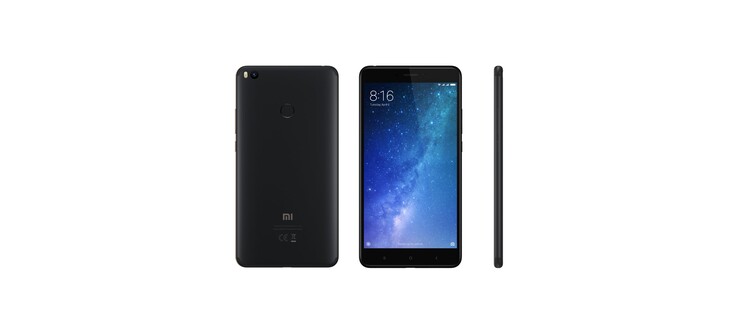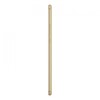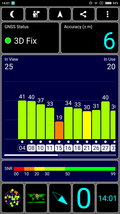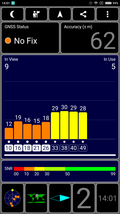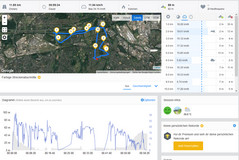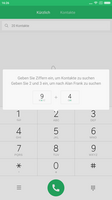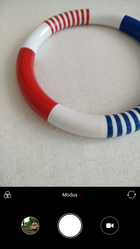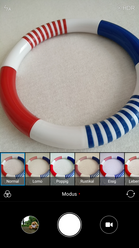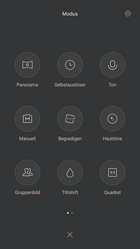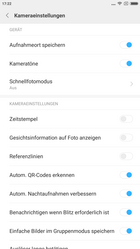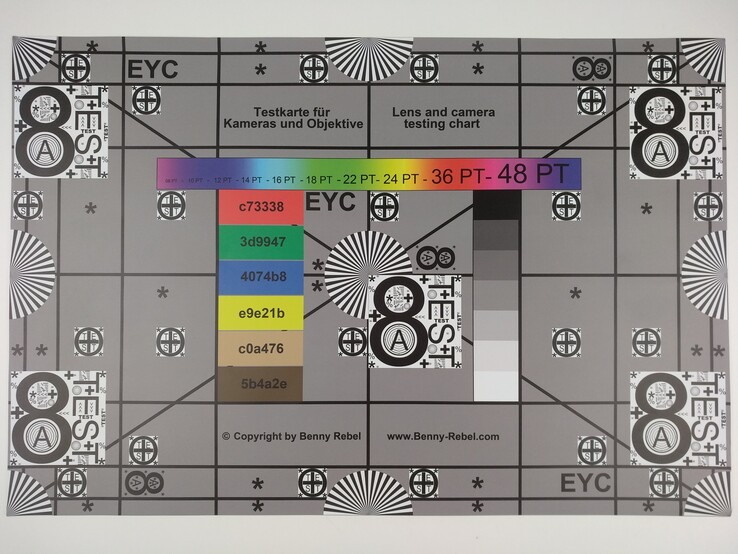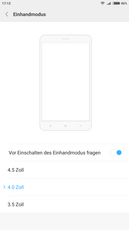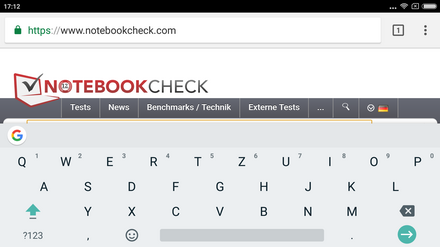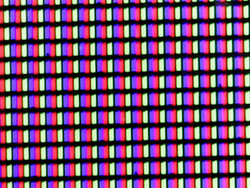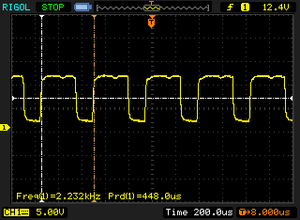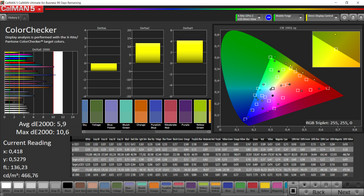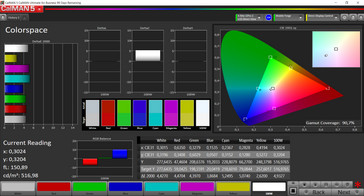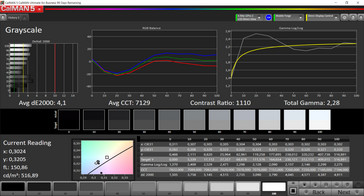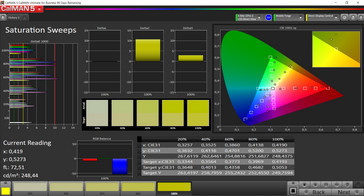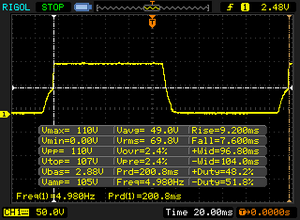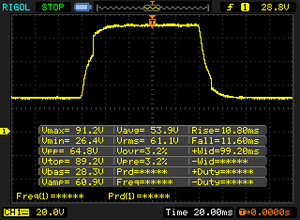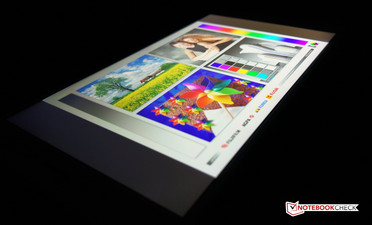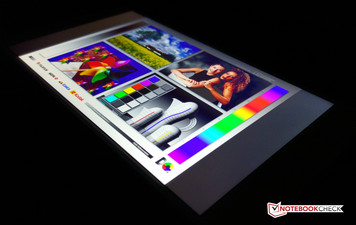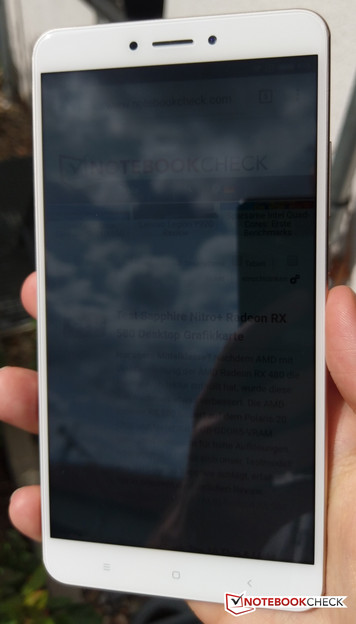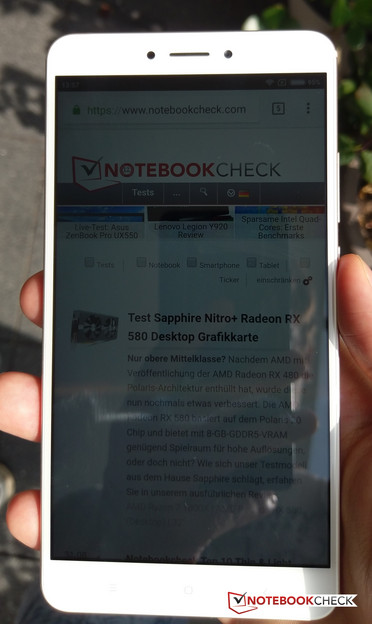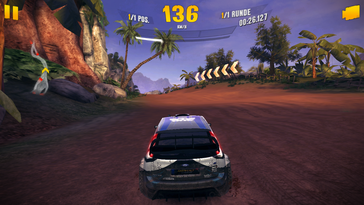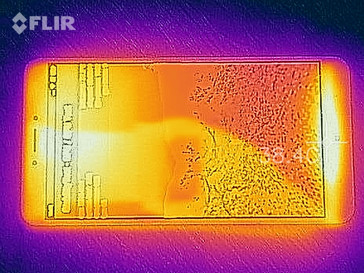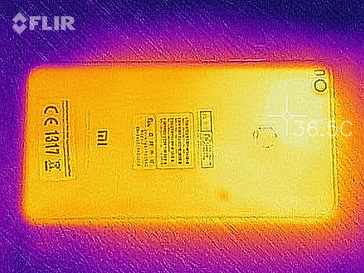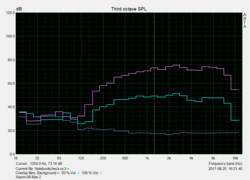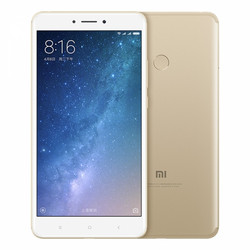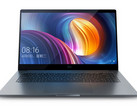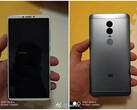Xiaomi Mi Max 2 Smartphone Review
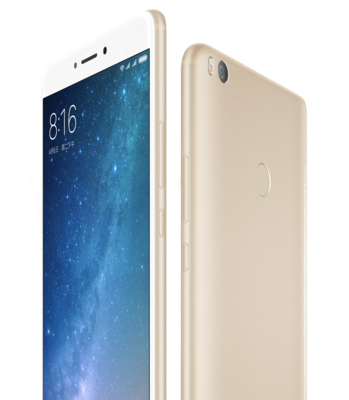
For the original German version, click here.
The XXL smartphone from the manufacturer Xiaomi is a lower mid-range device with very good technical specifications. The 6.44-inch phablet has a Snapdragon 625 SoC, 4 GB of RAM, stereo speakers, an IPS display with a resolution of 1920x1080 pixels, a 5300-mAh battery with Quick Charge technology that can be charged via a USB Type-C port as well as dual-SIM capability and a fingerprint sensor. The mid-range smartphone has 64 GB of internal storage that can be expanded via a hybrid slot. A version with 128 GB is also available for a few dollars more.
Due to its very large display, the Mi Max 2 does not have any real direct competition - at least not in this price range. That is why we have primarily chosen other mid-range smartphones with smaller displays, such as the LG X Power 2, Asus ZenFone 3 Max ZC520T and the Nokia 5 and ZTE Blade V8. The Lenovo Phab 2 Pro would be a real alternative as it also has a 6.4-inch screen, but it costs $500.
Case
The Xiaomi Max 2's aluminum unibody case gave us a very good impression. The curved back is mainly made of the metallic material with only the top and bottom area of the back made of plastic due to the antenna technology. You can hardly feel where one material ends and the other begins. We tested the gold version, but the device is also available in black.
Due to the large screen, the device is a little difficult to handle and not really suitable for users with small hands. The good display-to-surface ratio of 73.2% cannot change this. The weight of 211 grams (~7.4 oz) is fine considering the size of the device.
The device has a very good feel for its price. The volume rocker and on/off button are well made and have a noticeable pressure point. The device appears rather stable and did not warp.
Connectivity
The Xiaomi smartphone offers 64 GB of internal eMMC storage, which is a lot of space for this price range. After the first set up, users still have 51 GB available. You can also expand the internal memory with an SD card. According to the manufacturer, the microSD-slot supports memory cards with up to 128 GB. However, the SD cards cannot be configured as internal storage.
The USB port has the Type-C build with a USB 2.0 connector, which is used to charge the device. It also offers USB OTG, with which external storage devices and input devices can be connected to the phone.
The mid-range device also offers Wi-Fi Direct, an FM radio, an LED for notifications, an infrared transmitter and a fingerprint sensor. The wireless transmission of display content to external monitors via Miracast worked well with a Sony Android TV.
Software
Xiaomi has chosen to stick to the usual MiUI operating system, version 8.6, which is based on the current Google Android version 7.1.1. Because the Xiaomi Mi devices are produced with the Chinese market in mind, the manufacturer's software does not support Google services such as the Play Store or other Google apps such as Gmail ex-works. Instead, the phone comes with Chinese services and Xiaomi's own apps. There is a global version that supports Google services and other languages other than Chinese and English (including German). Should you buy a device without Google services, however, there is a way of installing the apps after purchase.
The operating system's interface looks very different from stock Android and there are a lot of options and settings. Installed apps are not collected in an App Drawer but distributed among the various home screens.
The MiUI design can be adapted individually in the manufacturer's Theme Store. However, most of the alternative themes are similar to the standard MiUI layout.
Communication & GPS
The Mi Max 2 uses HSPA+ (max. 42 MBit/s downstream) or LTE cat. 4 (max. 150 MBit/s downstream and 50 MBit/s upstream) to connect to mobile data. It has good frequency coverage but does not support LTE Band 20. The dual-SIM smartphone has two slots for a Nano-SIM and a Micro-SIM card, which both support the LTE network.
Bluetooth 4.2 deals with wireless communication. The device does not have an NFC chip.
The integrated Wi-Fi module supports the IEEE 802.11 standards a/b/g/n/ac. The Mi Max 2 also supports MIMO technology, which makes very high transfer rates possible. The transfer rates we measured between the XXL smartphone and our reference router Linksys EA 8500 were very good at 344 MBit/s and 253 MBit/s. Not even our test reference, the Huawei Mate 9, could keep up with these rates. Reception is good in everyday situations and the Wi-Fi signal is stable. We measured a small loss of -35 dBm in direct vicinity to the router (Telekom Speedport, W921V).
| Networking | |
| iperf3 transmit AX12 | |
| Lenovo Phab 2 Pro | |
| Xiaomi Mi Max 2 | |
| Huawei Mate 9 | |
| Nokia 5 | |
| ZTE Blade V8 | |
| LG X power2 | |
| Asus Zenfone 3 Max ZC520TL | |
| iperf3 receive AX12 | |
| Xiaomi Mi Max 2 | |
| Lenovo Phab 2 Pro | |
| Huawei Mate 9 | |
| Nokia 5 | |
| ZTE Blade V8 | |
| Asus Zenfone 3 Max ZC520TL | |
| LG X power2 | |
The Mi Max 2 uses the satellite systems GPS, GLONASS and BeiDou for positioning. The GPS module is reliable outdoors and locates the phone quickly within about six meters. Indoors, the smartphone was not able to locate us.
In order to get a better idea of the GPS capabilities, we took the Mi Max 2 on a bike ride. The Xiaomi smartphone had to compete with the bicycle computer Garmin Edge 500 over a distance of about 12 km (~7.5 mi). The difference between the measured routes is very small at 90 meters and the GPS can be considered more than sufficient for everyday needs.
Telephone & Call Quality
The call quality of the Mi Max 2 was good on both sides in the German Vodafone network. Sound from the earpiece is easy to understand, although maximum volume could be higher. Our caller was sometimes difficult to understand in louder surroundings.
Voices sound natural and the microphone's quality was described as very good by our contact.
Cameras
The 12-MP main camera has a resolution of 3968x2976 pixels and a 4:3 format. The camera module has an aperture of f/2.2 and phase detection autofocus. The 1/2.9-inch Sony CMOS image sensor (IMX386) is also used in the current flagship device Mi 6. The pixel edge length is a lot smaller than in other high-end Sony sensors at 1.25 micrometers, but it is good for a mid-range device.
The 12-MP camera records videos at a maximum resolution of 4K and 30 fps. It can also record in slow motion with 120 fps at 720p. If you use the front camera, you will have to make do with 1080p.
The quality of the photos is comparatively high - at least in good lighting. In bad lighting, the Sony sensor has a lot of image noise, which was to be expected due to the small edge length of the pixels and small aperture. In good lighting conditions, the back camera can make convincing pictures with good dynamics, little image noise and good sharpness. Remarkable for this price range.
The front camera has 5 megapixels and an aperture of f/2.0 with an 85 ° wide-angle radius. The quality is good considering the price and is suitable for selfies, although the quality is not as good as that of the main camera.
Accessories & Warranty
Apart from the Mi Max 2 itself, the box of our test unit also contained a user's manual in Chinese, a USB cable and a modular power supply for Chinese sockets. It also came with an EU adapter for European sockets, but this is not part of the standard scope of delivery. It is a special addition from Trading Shenzhen, which every buyer receives.
The warranty period is 12 months. Our test unit, provided by Trading Shenzhen, can be sent to a German address in the case of a warranty claim. We do not know if a similar service exists in the US or UK. Please see our Guarantees, Return policies and Warranties FAQ for country-specific information.
Input Devices & Handling
The capacitive touchscreen can register up to 10 inputs simultaneously and works fine in all areas. The surface is very sensitive and responds to the lightest touch.
There are three illuminated, capacitive keys for navigation below the display. Should the 6.44-inch screen become a little inconvenient in some situations, you can switch to one-hand mode by touching the capacitive keys from left to right. This worked very well in the test and was a nice little feature.
The active fingerprint reader on the back of the Mi Max 2 works reliably, but it is not the fastest sensor around.
Display
The IPS LC display of the Mi Max 2 has a screen diagonal of about 6.4-inches. This, and a resolution of 1080p, results in a pixel density of 342 ppi. This makes text, especially when the writing is small, appear a little blurry, but the pixel structure is hardly noticeable from a normal viewing distance. Considering the price, the "low" display sharpness of the Mi Max 2 is acceptable and is only noticeable compared to panels with higher resolutions.
The X-Rite i1Pro2 measured a maximum brightness of 542 cd/m². We measured a brightness of 496 cd/m² with APL 50, which looks at the luminosity with an even distribution of light and dark areas. Both these results are good for a mid-range device. We also measured a very low minimum brightness of below 2 cd/m². However, this is accompanied by PWM (Pulse-Width Modulation). It has a frequency of 2232 Hz at about 20% display brightness, which can lead to discomfort for sensitive users.
| |||||||||||||||||||||||||
Brightness Distribution: 92 %
Center on Battery: 530 cd/m²
Contrast: 1262:1 (Black: 0.42 cd/m²)
ΔE Color 5.9 | 0.5-29.43 Ø5
ΔE Greyscale 4.1 | 0.57-98 Ø5.3
Gamma: 2.28
| Xiaomi Mi Max 2 IPS, 1920x1080, 6.44 | Nokia 5 IPS, 1280x720, 5.20 | ZTE Blade V8 IPS, 1920x1080, 5.20 | LG X power2 IPS, 1280x720, 5.50 | Asus Zenfone 3 Max ZC520TL IPS, 1280x720, 5.20 | Lenovo Phab 2 Pro IPS, 2560x1440, 6.40 | Huawei Mate 9 IPS, 1920x1080, 5.90 | |
|---|---|---|---|---|---|---|---|
| Screen | -6% | -5% | -7% | -5% | -21% | 14% | |
| Brightness middle | 530 | 630 19% | 482 -9% | 237 -55% | 507 -4% | 472.4 -11% | 696 31% |
| Brightness | 523 | 635 21% | 448 -14% | 237 -55% | 474 -9% | 479 -8% | 680 30% |
| Brightness Distribution | 92 | 90 -2% | 79 -14% | 92 0% | 85 -8% | 93 1% | 93 1% |
| Black Level * | 0.42 | 0.57 -36% | 0.64 -52% | 0.13 69% | 0.53 -26% | 0.482 -15% | 0.42 -0% |
| Contrast | 1262 | 1105 -12% | 753 -40% | 1823 44% | 957 -24% | 980 -22% | 1657 31% |
| Colorchecker dE 2000 * | 5.9 | 5 15% | 4 32% | 5.5 7% | 4.7 20% | 7 -19% | 4.3 27% |
| Colorchecker dE 2000 max. * | 10.6 | 8.7 18% | 6.5 39% | 12.7 -20% | 7.2 32% | 11 -4% | 9.4 11% |
| Greyscale dE 2000 * | 4.1 | 6.9 -68% | 3.4 17% | 6.1 -49% | 4.8 -17% | 7.9 -93% | 4.8 -17% |
| Gamma | 2.28 96% | 2.37 93% | 2.13 103% | 2.07 106% | 2.25 98% | 2.34 94% | 2.33 94% |
| CCT | 7129 91% | 8736 74% | 6774 96% | 7943 82% | 6441 101% | 7826 83% | 7255 90% |
* ... smaller is better
Screen Flickering / PWM (Pulse-Width Modulation)
| Screen flickering / PWM detected | 2232 Hz | ≤ 17 % brightness setting | |
The display backlight flickers at 2232 Hz (worst case, e.g., utilizing PWM) Flickering detected at a brightness setting of 17 % and below. There should be no flickering or PWM above this brightness setting. The frequency of 2232 Hz is quite high, so most users sensitive to PWM should not notice any flickering. In comparison: 53 % of all tested devices do not use PWM to dim the display. If PWM was detected, an average of 17900 (minimum: 5 - maximum: 3846000) Hz was measured. | |||
The interplay of display brightness and a black value of 0.42 cd/m² results in a very good contrast ratio of 1:1262. However, our APL 50 measurement changed this good impression a little, as the black value increases to 0.67 cd/m² with evenly distributed light and dark areas, which in turn changes the contrast ratio to 1:713.
The photospectrometer and CalMAN software measured a color space deviation of 5.9 (colors) and 4.1 (grayscales), which is normal for this price range. The color temperature of the display is rather cool at 7129 Kelvin, but we did not see a blue cast in practice.
If you do not like the standard settings of the display, you can adjust the saturation and color temperature.
Display Response Times
| ↔ Response Time Black to White | ||
|---|---|---|
| 16.8 ms ... rise ↗ and fall ↘ combined | ↗ 9.2 ms rise | |
| ↘ 7.6 ms fall | ||
| The screen shows good response rates in our tests, but may be too slow for competitive gamers. In comparison, all tested devices range from 0.1 (minimum) to 240 (maximum) ms. » 33 % of all devices are better. This means that the measured response time is better than the average of all tested devices (21.5 ms). | ||
| ↔ Response Time 50% Grey to 80% Grey | ||
| 22.4 ms ... rise ↗ and fall ↘ combined | ↗ 10.8 ms rise | |
| ↘ 11.6 ms fall | ||
| The screen shows good response rates in our tests, but may be too slow for competitive gamers. In comparison, all tested devices range from 0.2 (minimum) to 636 (maximum) ms. » 28 % of all devices are better. This means that the measured response time is better than the average of all tested devices (33.7 ms). | ||
Performance
The Mi Max 2 is equipped with a Qualcomm Snapdragon 625 (SD625). The mid-range SoC is produced in a 14 nm FinFET process and integrates a processor with eight Cortex A53 cores from ARM. The integrated Qualcomm Adreno 506 graphics card supports modern programming interfaces such as Vulkan and OpenGL ES 3.1.
The cooperation between octa-core SoC and 4 GB of RAM ensures a mostly smooth system and browser performance in everyday use. There are a few minor judders during multitasking. Thanks to the system animations that can be deactivated in settings, the system runs well subjectively.
The Mi Max 2 gets good results in the benchmarks as well and can position itself at the top of the comparison field thanks to its GPU and CPU power.
| AnTuTu v6 - Total Score (sort by value) | |
| Xiaomi Mi Max 2 | |
| Nokia 5 | |
| ZTE Blade V8 | |
| LG X power2 | |
| Asus Zenfone 3 Max ZC520TL | |
| Huawei Mate 9 | |
| PCMark for Android | |
| Work performance score (sort by value) | |
| Xiaomi Mi Max 2 | |
| Nokia 5 | |
| ZTE Blade V8 | |
| LG X power2 | |
| Asus Zenfone 3 Max ZC520TL | |
| Huawei Mate 9 | |
| Work 2.0 performance score (sort by value) | |
| Xiaomi Mi Max 2 | |
| Nokia 5 | |
| ZTE Blade V8 | |
| LG X power2 | |
| Huawei Mate 9 | |
| Geekbench 4.4 | |
| 64 Bit Single-Core Score (sort by value) | |
| Xiaomi Mi Max 2 | |
| Nokia 5 | |
| LG X power2 | |
| Huawei Mate 9 | |
| 64 Bit Multi-Core Score (sort by value) | |
| Xiaomi Mi Max 2 | |
| Nokia 5 | |
| LG X power2 | |
| Huawei Mate 9 | |
| GFXBench (DX / GLBenchmark) 2.7 | |
| T-Rex Onscreen (sort by value) | |
| Xiaomi Mi Max 2 | |
| Nokia 5 | |
| ZTE Blade V8 | |
| LG X power2 | |
| Asus Zenfone 3 Max ZC520TL | |
| Huawei Mate 9 | |
| 1920x1080 T-Rex Offscreen (sort by value) | |
| Xiaomi Mi Max 2 | |
| Nokia 5 | |
| ZTE Blade V8 | |
| LG X power2 | |
| Asus Zenfone 3 Max ZC520TL | |
| Huawei Mate 9 | |
| GFXBench 3.0 | |
| on screen Manhattan Onscreen OGL (sort by value) | |
| Xiaomi Mi Max 2 | |
| Nokia 5 | |
| ZTE Blade V8 | |
| LG X power2 | |
| Asus Zenfone 3 Max ZC520TL | |
| Huawei Mate 9 | |
| 1920x1080 1080p Manhattan Offscreen (sort by value) | |
| Xiaomi Mi Max 2 | |
| Nokia 5 | |
| ZTE Blade V8 | |
| LG X power2 | |
| Asus Zenfone 3 Max ZC520TL | |
| Huawei Mate 9 | |
| GFXBench 3.1 | |
| on screen Manhattan ES 3.1 Onscreen (sort by value) | |
| Xiaomi Mi Max 2 | |
| Nokia 5 | |
| ZTE Blade V8 | |
| LG X power2 | |
| Asus Zenfone 3 Max ZC520TL | |
| Huawei Mate 9 | |
| 1920x1080 Manhattan ES 3.1 Offscreen (sort by value) | |
| Xiaomi Mi Max 2 | |
| Nokia 5 | |
| ZTE Blade V8 | |
| LG X power2 | |
| Asus Zenfone 3 Max ZC520TL | |
| Huawei Mate 9 | |
| GFXBench | |
| on screen Car Chase Onscreen (sort by value) | |
| Xiaomi Mi Max 2 | |
| Nokia 5 | |
| ZTE Blade V8 | |
| LG X power2 | |
| Huawei Mate 9 | |
| 1920x1080 Car Chase Offscreen (sort by value) | |
| Xiaomi Mi Max 2 | |
| Nokia 5 | |
| ZTE Blade V8 | |
| LG X power2 | |
| Huawei Mate 9 | |
The web performance appears to be good, too. The Chrome benchmarks confirm this impression and the Mi Max 2 beat all the comparison devices.
| JetStream 1.1 - Total Score | |
| Huawei Mate 9 (Chrome 54) | |
| Xiaomi Mi Max 2 (Chrome Version 60) | |
| Nokia 5 (Chrome 56.0.2924.87) | |
| ZTE Blade V8 (Chrome 57.0.2987.132) | |
| LG X power2 (Chrome 59) | |
| Asus Zenfone 3 Max ZC520TL (Chrome 55) | |
| Octane V2 - Total Score | |
| Huawei Mate 9 (Chrome 54) | |
| Xiaomi Mi Max 2 (Chrome Version 60) | |
| Nokia 5 (Chrome 56.0.2924.87) | |
| ZTE Blade V8 (Chrome 57.0.2987.132) | |
| LG X power2 (Chrome 59) | |
| Asus Zenfone 3 Max ZC520TL (Chrome 55) | |
| Mozilla Kraken 1.1 - Total | |
| Asus Zenfone 3 Max ZC520TL (Chrome 55) | |
| LG X power2 (Chrome 59) | |
| ZTE Blade V8 (Chrome 57.0.2987.132) | |
| Nokia 5 (Chrome 56.0.2924.87) | |
| Xiaomi Mi Max 2 (Chrome Version 60) | |
| Huawei Mate 9 (Chrome 54) | |
* ... smaller is better
Xiaomi has given the Mi Max 2 an eMMC storage with 64 GB. The speed of this internal storage is quite fast both in sequential reading and writing - at least for an eMMC storage. The microSD-card slot also had reliable transfer rates with our reference card, the Toshiba Exceria Pro M501. The results were average but definitely not bad.
| Xiaomi Mi Max 2 | Nokia 5 | ZTE Blade V8 | LG X power2 | Asus Zenfone 3 Max ZC520TL | Huawei Mate 9 | |
|---|---|---|---|---|---|---|
| AndroBench 3-5 | -13% | 4% | -24% | -43% | 27% | |
| Sequential Read 256KB | 265.7 | 255.6 -4% | 278.1 5% | 243.8 -8% | 174.2 -34% | 594 124% |
| Sequential Write 256KB | 139.6 | 74.9 -46% | 77.7 -44% | 41.7 -70% | 65.2 -53% | 142.9 2% |
| Random Read 4KB | 37.1 | 40.54 9% | 39.89 8% | 25.3 -32% | 20.9 -44% | 94.7 155% |
| Random Write 4KB | 12.81 | 8.39 -35% | 12.69 -1% | 10.7 -16% | 9.1 -29% | 8.77 -32% |
| Sequential Read 256KB SDCard | 83.6 ? | 83.9 0% | 96.5 ? 15% | 76.6 ? -8% | 47.67 ? -43% | 54 ? -35% |
| Sequential Write 256KB SDCard | 62.5 ? | 62 -1% | 87.1 ? 39% | 58.1 ? -7% | 29.59 ? -53% | 29.53 ? -53% |
Games
The integrated graphics unit Qualcomm Adreno 506 manages to display demanding 3D games smoothly (mostly), despite its comparatively low performance capacity. Current Android games such as Dead Trigger 2 or the racing game Asphalt could be played without any problems during our test. Our benchmark showed that the Adreno 506 GPU managed 30 fps or more in similarly equipped smartphones. The touchscreen responds very well and the sensors are reliable.
Emissions
Temperature
The surface temperature was rather low in our measurements. Temperatures did not surpass 29.7 °C (~85.5 °F, back) while idling, and the Mi Max 2 reached a maximum of 33.9 °C (~93 °F) under continuous load. Temperature development is no problem during everyday use.
(+) The maximum temperature on the upper side is 35.4 °C / 96 F, compared to the average of 35 °C / 95 F, ranging from 21.9 to 56 °C for the class Smartphone.
(+) The bottom heats up to a maximum of 33.9 °C / 93 F, compared to the average of 33.8 °C / 93 F
(+) In idle usage, the average temperature for the upper side is 31.5 °C / 89 F, compared to the device average of 32.7 °C / 91 F.
Speakers
The sound quality of the stereo speakers is very good for this price range. They offer balanced acoustics, which, combined with the stereo effect and large display, are destined for playing YouTube videos.
We measured a maximum volume of just under 84 dB(A) during our test. This is a good value which is easily loud enough for everyday use. As expected, highs are very present while the sound image lacks bass completely. The Pink Noise diagram shows that very high tones over 9 KHz are underrepresented while low frequencies between 250 and 700 MHz are very audible.
The 7.9-mm thick case of the Mi Max 2 also has an audio jack, which means that all conventional headphones can be plugged in for a better sound experience.
Xiaomi Mi Max 2 audio analysis
(+) | speakers can play relatively loud (84 dB)
Bass 100 - 315 Hz
(-) | nearly no bass - on average 23.7% lower than median
(±) | linearity of bass is average (9.8% delta to prev. frequency)
Mids 400 - 2000 Hz
(+) | balanced mids - only 2.5% away from median
(+) | mids are linear (4.1% delta to prev. frequency)
Highs 2 - 16 kHz
(+) | balanced highs - only 3.2% away from median
(+) | highs are linear (2.8% delta to prev. frequency)
Overall 100 - 16.000 Hz
(±) | linearity of overall sound is average (17.3% difference to median)
Compared to same class
» 8% of all tested devices in this class were better, 6% similar, 86% worse
» The best had a delta of 12%, average was 38%, worst was 134%
Compared to all devices tested
» 27% of all tested devices were better, 8% similar, 65% worse
» The best had a delta of 4%, average was 25%, worst was 134%
LG X power2 audio analysis
(+) | speakers can play relatively loud (89.4 dB)
Bass 100 - 315 Hz
(-) | nearly no bass - on average 42.2% lower than median
(+) | bass is linear (1.7% delta to prev. frequency)
Mids 400 - 2000 Hz
(±) | reduced mids - on average 13.1% lower than median
(±) | linearity of mids is average (11% delta to prev. frequency)
Highs 2 - 16 kHz
(±) | higher highs - on average 6.2% higher than median
(+) | highs are linear (5.2% delta to prev. frequency)
Overall 100 - 16.000 Hz
(-) | overall sound is not linear (31.5% difference to median)
Compared to same class
» 78% of all tested devices in this class were better, 3% similar, 19% worse
» The best had a delta of 12%, average was 38%, worst was 134%
Compared to all devices tested
» 88% of all tested devices were better, 2% similar, 9% worse
» The best had a delta of 4%, average was 25%, worst was 134%
Frequency diagram in comparison (checkboxes can be turned on/off!)
Battery Runtime
Power Consumption
The power consumption of the Mi Max 2 is surprisingly efficient for a 6.44-inch device. It is more or less on the same level as those of our comparison devices, but they all have significantly smaller displays and less powerful SoCs.
| Off / Standby | |
| Idle | |
| Load |
|
| Xiaomi Mi Max 2 5300 mAh | Nokia 5 3000 mAh | ZTE Blade V8 2730 mAh | LG X power2 4500 mAh | Asus Zenfone 3 Max ZC520TL 4100 mAh | Huawei Mate 9 4000 mAh | |
|---|---|---|---|---|---|---|
| Power Consumption | -4% | -18% | -30% | -41% | -48% | |
| Idle Minimum * | 0.6 | 0.52 13% | 0.98 -63% | 0.63 -5% | 0.74 -23% | 0.78 -30% |
| Idle Average * | 1.75 | 1.78 -2% | 1.76 -1% | 1.42 19% | 2.04 -17% | 2.13 -22% |
| Idle Maximum * | 1.87 | 1.96 -5% | 1.79 4% | 1.47 21% | 2.22 -19% | 2.17 -16% |
| Load Average * | 2.76 | 3.23 -17% | 2.89 -5% | 5.89 -113% | 5.57 -102% | 6.32 -129% |
| Load Maximum * | 4.51 | 4.88 -8% | 5.62 -25% | 7.85 -74% | 6.59 -46% | 6.49 -44% |
* ... smaller is better
Battery Runtime
The 5300-mAh battery lasted over 18 hours during our Wi-Fi surfing test with adjusted brightness. This is a very long time. The Mi Max 2 recharges very quickly thanks to Quick Charge 3.0 and the provided 18-watt power supply (9V/2A).
| Xiaomi Mi Max 2 5300 mAh | Nokia 5 3000 mAh | ZTE Blade V8 2730 mAh | LG X power2 4500 mAh | Asus Zenfone 3 Max ZC520TL 4100 mAh | Huawei Mate 9 4000 mAh | |
|---|---|---|---|---|---|---|
| Battery Runtime | ||||||
| WiFi v1.3 | 1091 | 713 -35% | 700 -36% | 982 -10% | 814 -25% | 758 -31% |
Pros
Cons
Verdict
Xiaomi has put an interesting smartphone on the market. If you accept the enormous size of the 6.44-inch Mi Max 2, you will get a decent package for about $360. Considering its price, the mid-range device has hardly any noteworthy weaknesses.
Hats off to Xiaomi! We can definitely recommend the Mi Max 2 to anyone who appreciates smartphones with large displays and can accept the restrictions of an imported device.
Unfortunately, the Chinese manufacturer has missed out on updating the second generation of the Mi Max series with a more up-to-date SoC and a modern (borderless) design.
Xiaomi Mi Max 2
-
09/04/2017 v6(old)
Marcus Herbrich


 Deutsch
Deutsch English
English Español
Español Français
Français Italiano
Italiano Nederlands
Nederlands Polski
Polski Português
Português Русский
Русский Türkçe
Türkçe Svenska
Svenska Chinese
Chinese Magyar
Magyar